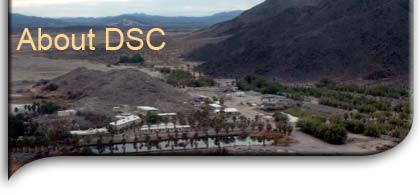|

About the Desert
Studies Center
The Desert Studies Center, field station of the California State University (CSU), provides opportunity for individuals and groups to conduct research, receive instruction and experience the desert environment. Established in 1976 under a cooperative management agreement with the Bureau of Land Management, the Center is operated for the CSU by the California Desert Studies Consortium, an organization of seven southern California CSU campuses: Dominguez Hills, Fullerton, Long Beach, Los Angeles, Northridge, Pomona and San Bernardino. With the passage of the California Desert Protection Act of 1994, the Desert Studies Center was placed into the Mojave National Preserve. History Soda Springs itself is of great interest to archaeologists, biologists and historians. During 1860 the site served as a US Army outpost, and was called Hancock's Redoubt. Evidence of prehistoric and historic activity are readily seen, including prehistoric quarry sites and artifacts of ancient man, such as; projectile points and rock art, the historic Mojave Road, remnants of a wagon road stop, evaporative salt mining, mill sites, and the Tonapah and Tidewater Railroad. Many relics remain from the Zzyzx Mineral Springs and Health Spa era, which lasted for thirty years ending in 1974. Soda Springs Biologists find Soda Springs of particular interest. The Mojave Tui Chub, Gila bicolor mohavensis, an endangered fish species, in the minnow family, inhabits local ponds with another Mojave Desert native, the Saratoga Spring Pupfish, Cyprinodon nevadensis. In addition, a variety of desert reptiles and mammals are observed at Soda Springs. Mammals include pocket mice, kangaroo rats, antelope ground squirrel, bobcat, ring-tailed cat, kit fox, gray fox, coyote, and several species of bats. Reptiles include chuckwalla, leopard, collared, whiptail, and zebratail lizards, shovelnose snake, mojave green, sidewinder and speckled rattlesnakes, gopher snake, red racer and the endangered California desert tortoise. The sole amphibian is the pacific tree frog. One hundred and ninty-two species of birds have been sighted at the Center. Habitat This rich variety of wildlife results from the diverse habitats and plant communities located near the Center. These include halophytic vegetation, marsh communities, ponds and springs with pondweed, cattail and sedges, extensive creosote bush scrub and saltbush scrub stands, crescent sand dunes with psammophilous vegetation and plants stabilized by mesquite thickets and the rocky slopes and ravines of the Soda Mountains. Wildflowers in spring carpet the ground. The existence of these biological and cultural resources as well as rich geological research opportunities in the vicinity have made possible a number of field and laboratory investigations. Recent and ongoing research projects conducted by Center investigations include:
|
Why "Zzyzx"?
In 1944, Curtis Howe Springer settled on three by eight miles by Soda Dry Lake in the middle of the Mojave Desert. There he built a spa with nine mineral pools in the shape of a cross, and he wanted to give it name with no vowels that sounded like sleep, and so "Zzyzx" (pronounced Zee–zix or Zie–zix, whichever source you read) was born. The self-proclaimed Methodist minister and physician (he was neither) broadcasted daily a folksy, fundamentalist religious program from the radio station he built there asking listeners to send donations for miraculous cures, which were a mix of vegetable juices, shipped throughout the United States and abroad.
The spa flourished with the elderly spending their life savings to spend time in the sparse rooms and to relax in the mineral waters until 1974, when Springer was arrested for alleged violations of food and drug laws and unauthorized use of federal land. The spa was confiscated, Springer spent a few months in jail, and now the spa is administered by the California State University at Fullerton as the Desert Studies Center. What had been a location with a colorful history that is the stuff of legend, became a place where education and protection of the desert flourish, and where everyone and the desert environment benefits. |